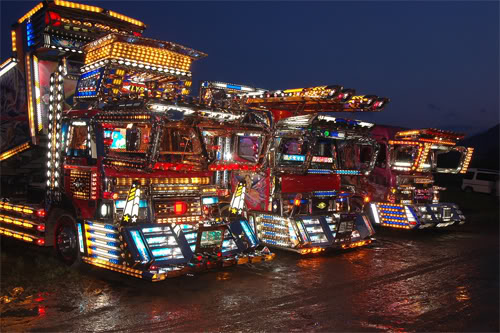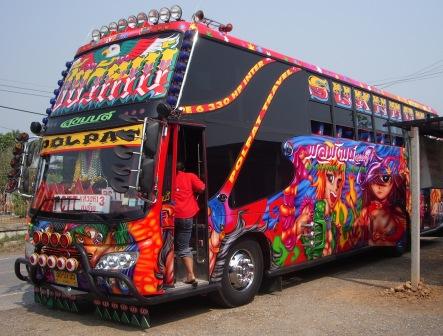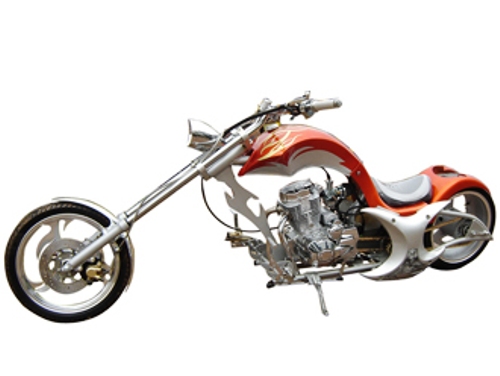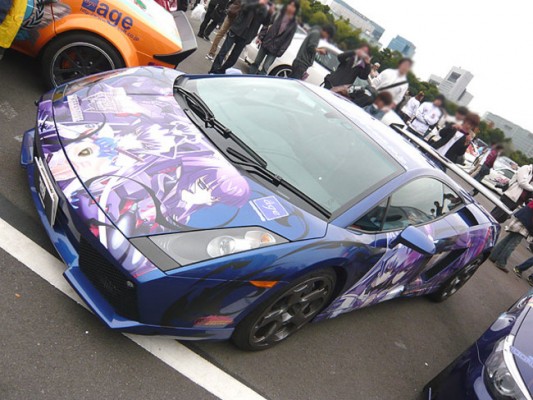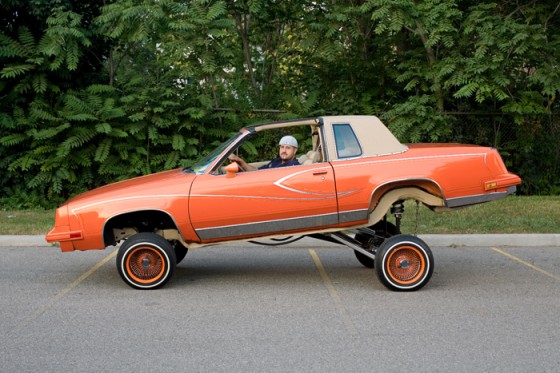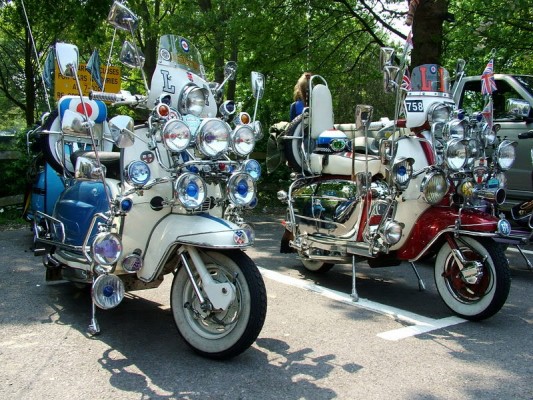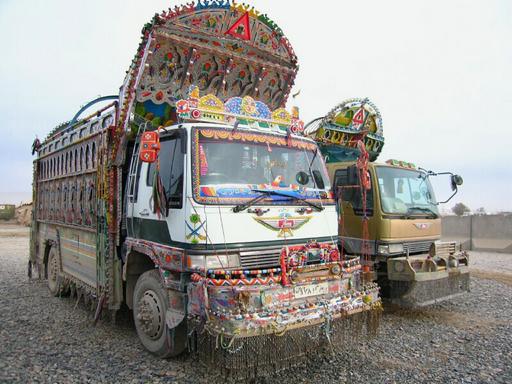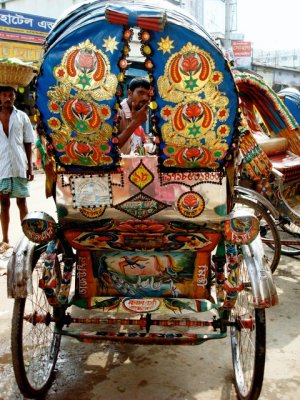No matter where you go in the world, vehicles play a major role in almost every aspect of our lives. Vehicle ownership is seen by most as an essential part of existence in the modern world. Whether for pleasure or economic necessity, just about all of us will want or need to own a vehicle at some point. Is it any wonder then that around the world, people have taken their vehicles and made them into works of art? What better way to show your love and appreciation for your vehicle than decorating it with love and care? Here is my top 10 customized vehicles from around the world:
10. Dekotora (Japan)
Long thought of as a homogenous culture of cubicle drones, the Japanese can actually be just as creative and weird as anyone. Dekotora (an abbreviation of “decoration truck”) is a perfect example of how individualistic the Japanese can be. Built and owned by independent truckers, dekotora are regular trucks modified to look like the front of a Las Vegas casino. Except not so boring. A tangle of lights, decals, and massive chrome fixtures, these trucks light up the Japanese highways and rest stops as their owners gather to show off their designs. No two trucks are the same and owners take pride in making their trucks as outlandish as possible. Best of all, these trucks are actually used to transport goods.
9. Tourist Buses (Thailand)
Like dekotora in Japan, Thai tourist buses are riots of color and design. Custom painted by professionals who devote their lives to the art, these buses cruise around Thailand decorated with millions of different designs and images. From Disney characters to Japanese anime scenes, nothing is too outlandish or colorful to be masterfully rendered on the side of a bus. In fact, the custom painted buses are so widespread that the only kind of bus that would stand out on the streets of Bangkok is one with a regular paint job. In the tourist bus industry, garish colors and giant cartoon characters are the norm. Say what you want about these buses, but they sure beat getting into some crappy old grey Greyhound.
8. Choppers (U.S.A.)
At the end of World War 2, millions of returning GI’s found themselves back home with a thirst for excitement that postwar life couldn’t satisfy. Many of them purchased motorcycles to enjoy the speed and freedom of the open road, but found the factory versions bulky and full of unnecessary parts. Putting the skills Uncle Sam had taught them to peaceful use, they modified and “chopped” their bikes to make them leaner and faster. Over the next twenty years, the art developed and a huge subculture was born. Although choppers largely faded from the public eye over the years, they saw a resurgence in the 2000’s with shows like American Chopper and brands like West Coast Choppers marketing the customized bikes to a new generation. Highly modified, dangerous and loud; perhaps no other custom vehicle better symbolizes the U.S.A. Which is lucky because that’s the only country in the world where you can legally drive one.
7. Itasha (Japan)
Let’s say you finally have enough money and power to buy that Italian sports car you’ve always dreamed of. A masterpiece of automotive engineering and raw power, it looks just as cool as it feels. Obviously, the first thing you’re going to do is run out and blow a whole bunch more money to have a sexy cartoon character painted on it, right? Strange as it may seem, for a group of car enthusiasts in Japan, that’s exactly what they do. Known as itasha (which means “pain car”- “pain” for “painfully embarrassing” or “painful on the wallet” – really) these cars are primarily owned, operated, and shown off by guys whose love for performance vehicles is matched only by their desire to make love to a cartoon. Although the itasha are starting to be seen in actual races and sponsored by actual companies, it’s still largely a labor of love. For the men who devote a sizable chunk of their pay checks to letting the world know just how much they love that cartoon schoolgirl with the pink hair, no amount is too much.
6. Lowriders (U.S.A.)
Although they’ve come to be associated with West Coast hip hop culture in recent years, lowriders have always been an integral part of Chicano culture. First built by Mexican Americans as far back as the 30s, lowriders and the culture around them developed and flourished during the postwar boom. Like the ex-soldiers who cut up their choppers, lowrider enthusiasts heavily modified their cars to ride as low as possible. After first using sandbags and cinder blocks, they moved on to actually cutting and shortening their cars. The goal was to be as “low and slow” as possible. One of the most famous lowrider modifications, hydraulics, was actually done as a response to a punitive law enacted by the state of California. Not pleased to have a bunch of what they saw as undesirables driving low and slow through their neighbourhoods, the state made it illegal to have any part of a car lower than its rims. To get around the law, one enterprising customizer took some pumps from an old B-52 bomber and invented a system where he could raise or lower his car depending on whether there were any cops around.
5. Mod Scooters (U.K.)
The Swinging Sixties may have produced a lot of great music, but at its heart, it was all about style. From the James Bond dinner jackets to the Emma Peel cat suits, the secret mission in 1960’s London was to look as cool as humanly possible, and to spare no expense doing it. One of the more popular subcultures of the time, the mods, expressed their undying love of fashion in their motor scooters. Although they were largely working class kids, mods were influenced by Italian culture and fashion and loved the cheap, sleek Vespa and Lambretta scooters. Once they got them, they heavily modified their exteriors- especially the mirrors and lights. Not content to limit themselves to just two mirrors or one light, some Mods crammed as many rear-view mirrors and headlights as they could on their scooters. Never before or since in the history of motor vehicles has being safe been so cool.
4. Jingle Trucks (Central Asia)
Though the name may sound silly (and maybe even a little offensive) jingle trucks are nothing to laugh at. These heavily adorned commercial vehicles are common throughout Central Asia, but the most elaborate are found in Afghanistan, India, and Pakistan. Covered in colorful paintings of houses, animals, vehicles, and pastoral landscapes, the jingle trucks are amazing to look at. Despite a common look, each truck is unique and is meant to be a reflection of the owner’s tastes and personality. One image common to most trucks is a human eye, meant to ward off evil spirits. But what sets the jingle trucks apart from other custom vehicles (and gives them their name) is of course the jingling. To get the signature sound, jingle trucks’ bumpers are decorated with long chains and charms hanging like curtains. In the harsh Afghan wind, these chain curtains act as wind chimes, letting everyone know a jingle truck is approaching. That’s if they haven’t yet see the giant painted eye staring at them.
3. Jeepneys (Philippines)
Originally built on the husks of surplus and worn out U.S. Army jeeps, jeepneys are a great example of how one man’s trash is another man’s treasure. When the U.S. army withdrew from the Philippines after World War 2, they sold or gave hundreds of their surplus jeeps to the locals. Happy to have a vehicle, but not so happy to have one designed for transporting soldiers, the Filipinos stripped the jeeps, extended the cabs, added roofs, and painted over the boring army green with all kinds of bright colors. The resulting vehicles were way more fun to look at and served a vital role in re-establishing public transportation in a country still trying to rebuild after years of occupation. They became a part of the culture and still exist today, although they aren’t built from old army jeeps anymore. Some manufacturers have even started to build “e-jeepneys,” jeepneys that run on electricity. These jeepneys of the future will help to ensure that the streets of the Philippines will never be drab, even after the oil runs out.
2. Customized Vans (U.S.A.)
Does anything say “The Seventies” quite like a customized boogie van? Although they first came to prominence among hippies and surfers in the Sixties, custom vans really came into their cheesy own after 1970. Inside, they were mobile living room masterpieces of shag carpeting, strobe lights and if you were really lucky, a mini-fridge full of cold brews and panty peeler. Outside, they were low culture tributes to the heroes of the day. Every sci-fi and fantasy character from Conan to C3PO was immortalized in air-brushed glory for all to see. Custom van culture combined the free-wheeling nomadism of the Sixties with the do-anything-to-feel-good hedonism of the Seventies. Moving fortresses of comfort, they cruised the streets and beaches, bringing all the comforts of home anywhere there was pavement. All that and they had wicked pictures of barbarians kicking major ass.
1. Custom Rickshaws (India)
The only human-powered vehicles on the list, the custom rickshaws of India prove that just because your vehicle doesn’t have an engine, doesn’t mean you can’t trick it out. Although their use has largely faded in other parts of the world, rickshaws remain a common form of transportation in many cities in India and Bangladesh. Used as a cheap way to get around, rickshaws are an integral part of the transportation system. But what makes them great is the art. Covered in oil paintings that depict everything from movie stars to products to political commentary, they reflect the owner’s opinions and feelings while giving other people on the road something very cool to look at. In the past, elites looked down on the paintings as gauche examples of low-class culture, but recently artists and scholars have started to take them seriously as an art form. All this, and they’re environmentally friendly!




